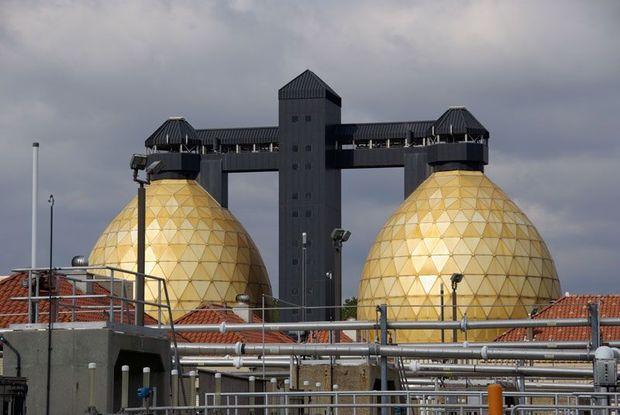The Environmental Integrity Project (EIP) today released a report highlighting the 21 wastewater plants across the Chesapeake Bay watershed that violated their permit limits last year by releasing excessive amounts of nitrogen or phosphorus pollution, that fuel algal blooms and low-oxygen "dead zones." The report, "Sewage and Wastewater Plants in the Chesapeake Bay Watershed, also offers recommendations on how Bay states could better manage this water pollution. We've highlighted some of the main points, taken directly from EIP.

As for the purpose of the report, EIP States:
With Maryland Governor Larry Hogan’s Administration proposing new regulations to allow pollution trading next month, this report on wastewater treatment plants documents how pollution credit swaps in Virginia and Pennsylvania contribute to local pollution 'hot spots' and reduce accountability."
Plant Upgrades
Modernizing sewage treatment plants has proven over the last half century to be the most successful method of improving local water quality and the Chesapeake Bay. But the regional states have not invested equally in upgrading wastewater plants, and several several wastewater treatment plant upgrade projects have fallen behind schedule for the bay cleanup plan.
Pollution Trading
Certain states, including Virginia and Pennsylvania, use a system of pollution trading, which allows facilities that want to dump excess pollution into waterways do so, while avoiding legal jeopardy, if their operators send money (through the purchase of pollution credits) to other sewage plants, industrial facilities or farms that reduce their pollution below levels allowed by the EPA bay cleanup plan.
In both Virginia and Pennsylvania, pollution credit trading systems allowed many plants that were over their limits to buy their way out of violations. The credit swaps in these Wall-Street style schemes reduce transparency and accountability and contribute to local pollution 'hot spots.'
Recommendations
1. The bay region states should more consistently fine wastewater treatment plants and other polluters that violate their permit limits.
2. Pollution trading systems, like those of Virginia and Pennsylvania, should be avoided in Maryland and other states not already employing them because they can lead to reduced accountability and increased local pollution “hot spots.”
3. States that do allow facilities to engage in pollution trading should require the plants to accurately and promptly report, to public databases, credits purchases and their impact.
4. EPA should press bay region states to upgrade more of their large municipal wastewater treatment plants with state-of-the art technology. This is especially true in Pennsylvania, New York and Delaware, which have not upgraded their sewage plants to the same enhanced level as many in Maryland, Virginia and the District of Columbia.
Progress
According to the
Maryland Department of the Environment (MDE), 53 of the 67 sewage plant upgrade projects have been completed, eliminating 6.3 million pounds of nitrogen and 500,000 pounds of phosphorus annually. Eleven more projects are under construction or in testing phases.
While Maryland has paid about $1.25 billion to upgrade 79 percent of its large municipal sewage plants to enhanced (ENR) levels,
Virginia has invested about $800 million to improve about 44 percent (40 of 90) of its large municipal sewage plants to similar standards.
In
Pennsylvania, most plants have been upgraded to a lower level. Only four percent (7 of 189) of the large- to medium-sized municipal sewage treatment plants in the bay watershed of Pennsylvania have enhanced pollution control systems, according to EPA data.
Washington DC’s one sewage plant has been upgraded to an enhanced level. In
West Virginia, about half (6 out of 13) of wastewater plants have been modernized to this standard. In
New York and
Delaware, it’s zero percent (none out of 26 in New York and zero out of 3 in Delaware).
Overall, across the Chesapeake watershed since 1985, the states and District of Columbia have invested more than $7 billion to upgrade sewage treatment plants, reducing their overall nitrogen pollution into the bay by 57 percent and phosphorus by 75 percent, according to the EPA.
Data
This is just a sampling of one category of pollution data. For more details on the Maryland plants mentioned below, as well as specifics on plants in other Bay states exceeding permit limits for Nitrogen and/or phosphorous, click to the full
EIP report.
Table: Maryland Sewage Plants Exceeding Permit Limits for Nitrogen, 2016
| Facility |
Nitrogen Pollution Discharged (lbs) |
Permit Limit (lbs) |
Percent Over Limit |
Main Receiving Waterway |
| Patapsco WWTP (Baltimore) |
3,704,300 |
889,300 |
317% |
Patapsco River |
| Back River WWTP (Baltimore) |
3,618,282 |
2,799,655 |
29% |
Back River |
| Westminster WWTP (Westminster) |
71,619 |
60,911 |
18% |
Upper Little Pipe Creek |
| Salisbury WWTP (Salisbury) |
416,651 |
103,549 |
302% |
Wicomico River |
| Frederick City WWTP (Frederick) |
199,962 |
97,458 |
105% |
Monocacy River |
| Chesapeake Beach WWTP (Chesapeake Beach) |
25,542 |
18.273 |
40% |
Herring Bay |
| Cox Creek WRF (Curtis Bay) |
277,643 |
182,734 |
52% |
Patapsco River |
| Marlay-Taylor WWTP (Lexington Park) |
84,816 |
73,093 |
16% |
Saint Jerome Creek |
 As for the purpose of the report, EIP States:
As for the purpose of the report, EIP States: